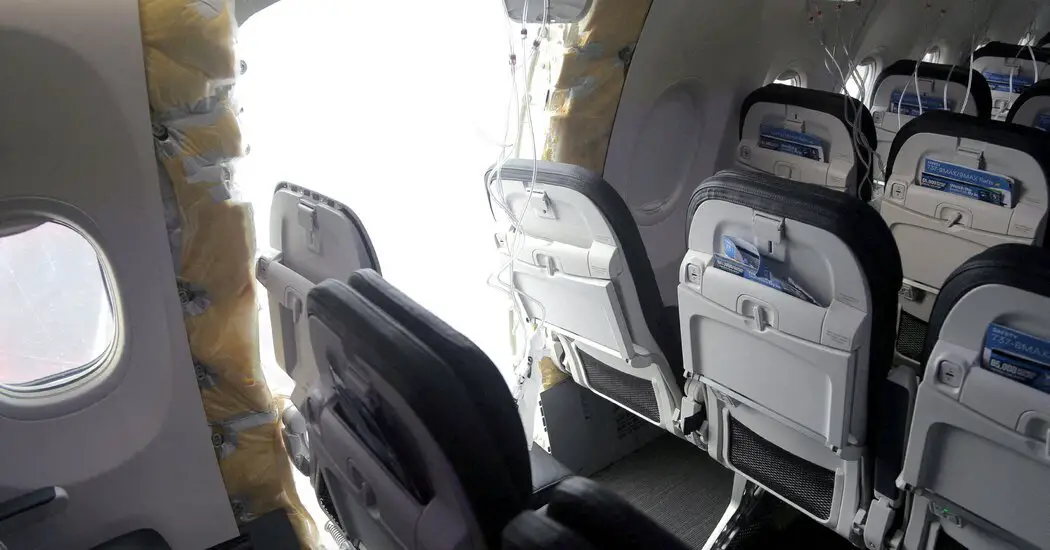The Justice Department has begun a criminal investigation into Boeing after a panel on one of the company’s planes blew out on an Alaska Airlines flight in early January, a person familiar with the matter said.
The airline said it was cooperating with the inquiry. “In an event like this, it’s normal for the D.O.J. to be conducting an investigation,” Alaska Airlines said in a statement. “We are fully cooperating and do not believe we are a target of the investigation.” Boeing had no comment.
On Jan. 5, a panel on a Boeing 737 Max 9 jet operated by Alaska Airlines blew out in midair, exposing passengers to the outside air thousands of feet above ground. There were no serious injuries resulting from that incident, but it could have been catastrophic had the panel blown out minutes later, at a higher altitude.
The panel is known as a “door plug” and is used to cover a gap left by an unneeded exit door. A preliminary investigation by the National Transportation Safety Board suggested that the plane may have left Boeing’s factory without the plug bolted down.
The criminal investigation was first reported by The Wall Street Journal.
The Justice Department has previously said it was reviewing a 2021 settlement of a federal criminal charge against the company, which stemmed from two fatal crashes aboard its 737 Max 8 plane. Under that agreement, Boeing committed to paying more than $2.5 billion, most of it in the form of compensation to its customers. The Justice Department agreed to drop the charge accusing Boeing of defrauding the Federal Aviation Administration by withholding information relevant to its approval of the Max. It was not immediately clear if the criminal investigation was related to the review of the 2021 settlement or a separate inquiry.
The deal was criticized for being too lenient on Boeing and for having been reached without consulting the families of the 346 people killed in those crashes. The first occurred in Indonesia in late 2018. After the second in Ethiopia in early 2019, the Max was banned from flying globally for 20 months. The plane resumed service in late 2020 and has since been used in several million flights, mostly without incident — until the Alaska Airlines flight on Jan. 5.
On Friday, Boeing informed a congressional panel that it had been unable to find a potentially important record detailing its work on the panel that later blew out.
The company had been asked to produce any documentation it had related to the removal and re-installation of the panel. In a letter to Senator Maria Cantwell, who chairs the Commerce, Science and Transportation Committee, Boeing said it had conducted an extensive search but could not find a record of the information being sought by the Senate panel and by the safety board.
“We likewise have shared with the N.T.S.B. what became our working hypothesis: that the documents required by our processes were not created when the door plug was opened,” the Boeing letter reads. “If that hypothesis is correct, there would be no documentation to produce.”
In the letter, Boeing also said that it had sent the N.T.S.B. all of the names of the individuals on the 737 door team on March 4, two days after it was requested.
The door plug was opened in September at Boeing’s factory in Renton, Wash., to repair damaged rivets on the plane’s fuselage, according to a document reviewed by The New York Times. Rivets are often used to join and secure parts on planes. The request to open the plug came from contractors working for Spirit AeroSystems, a supplier that makes the body for the 737 Max in Wichita, Kan.
According to the document, on Sept. 18, a Spirit AeroSystems mechanic was assigned to begin work to repair the rivets and the door plug was being opened so that the repairs could be made. The document shows that the repairs were completed two days later and the approval was given to close the door back up.
The document contained no details about who was assigned to reinstall the door plug or whether it was inspected after it was replaced. It does not contain any other information about which Boeing employees were involved in removing and replacing the door plug.
The blowout on the Jan. 5 flight once again elicited harsh scrutiny of Boeing’s practices, with lawmakers publicly criticizing the company. The National Transportation Safety Board is still investigating the incident, but suggested in a preliminary report that Boeing may have delivered the plane to Alaska without installing the bolts necessary to hold the door plug in place.
The F.A.A. has since increased inspections at the factory where Boeing makes the Max and has capped how many planes the company can make each month. An F.A.A. audit found quality lapses at Boeing, and the agency has given the company a few months to develop a plan to improve quality control.
Last month, an expert panel assembled by the F.A.A. released a long-awaited report stemming from the Max crashes. It concluded that Boeing’s safety culture was still lacking, despite improvements in recent years.

